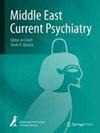Personality disorders among a sample of Egyptian patients with major depressive disorder and their association with suicide
IF 1.6
Q3 PSYCHIATRY
引用次数: 0
Abstract
Depression is a prevalent psychiatric disorder that can arise at any age and is often present as a co-occurring illness in different illnesses. There is a high comorbidity rate between major depressive disorder and personality disorders (PDs). The current study aimed to investigate the significant impact of personality disorders on depression severity, functional impairment, and suicidal tendencies in individuals with depression. The researchers conducted a cross-sectional observational study involving 120 patients, with an age range from 18 to 56 years of both genders, recruited from Okasha’s Institute of Psychiatry in Cairo, Egypt. Their major depressive disorder diagnosis was verified through the use of the Structured Clinical Interview for DSM-IV Axis I Disorders (SCID-I). Participants underwent evaluations using the SCID-II to evaluate personality disorders, the Hamilton Depression-Rating Scale (HAM-D) to assess the severity of depression, the Columbia Suicide Severity Rating Scale (C-SSRS) to investigate suicidal ideation, and the Global Assessment of Functioning Scale (GAF) to determine functional level. Borderline personality disorder and narcissistic personality disorder were the predominant personality disorders in the sample, with prevalence rates of 55.8% and 40.8%, respectively. Sixty-six percent of the participants reported experiencing suicidal thoughts at some point in their lifetime, whereas only 17.5% had actually attempted suicide. Borderline personality disorder showed a strong correlation with more severe depression (P value 0.043), a decline in functioning (P value 0.001), the existence of suicidal thoughts (P value 0.001), and a past of suicide attempts (P value 0.038). Personality disorders are highly prevalent in patients with depression, borderline PD, and narcissistic PD were the most common PDs. Borderline PD showed a significant effect on depression severity. PDs, mainly borderline, avoidant, depressive, and narcissistic PDs contribute to more impairment of functioning of the MDD patients. There is a significant effect of the presence of co-morbid personality disorder on suicidal thoughts and suicidal attempts, mainly depressive and borderline PDs.埃及重度抑郁症患者中的人格障碍及其与自杀的关系
抑郁症是一种常见的精神疾病,可发生于任何年龄段,并经常作为不同疾病的并发症出现。重度抑郁症与人格障碍(PDs)的合并率很高。本研究旨在调查人格障碍对抑郁症患者的抑郁严重程度、功能障碍和自杀倾向的重要影响。研究人员开展了一项横断面观察性研究,从埃及开罗的奥卡沙精神病学研究所招募了 120 名患者,男女患者的年龄在 18 至 56 岁之间。他们的重度抑郁障碍诊断是通过使用 DSM-IV 轴一疾病结构化临床访谈(SCID-I)来验证的。此外,还使用 SCID-II 评估人格障碍,使用汉密尔顿抑郁评定量表(HAM-D)评估抑郁的严重程度,使用哥伦比亚自杀严重程度评定量表(C-SRS)调查自杀意念,使用全球功能评估量表(GAF)确定功能水平。边缘型人格障碍和自恋型人格障碍是样本中最主要的人格障碍,患病率分别为 55.8% 和 40.8%。66%的受试者表示在一生中的某个阶段有过自杀的念头,而真正尝试过自杀的受试者仅占 17.5%。边缘型人格障碍与更严重的抑郁症(P 值为 0.043)、功能下降(P 值为 0.001)、存在自杀念头(P 值为 0.001)和自杀未遂经历(P 值为 0.038)密切相关。人格障碍在抑郁症患者中非常普遍,边缘型人格障碍和自恋型人格障碍是最常见的人格障碍。边缘型人格障碍对抑郁严重程度有显著影响。边缘型人格障碍、回避型人格障碍、抑郁型人格障碍和自恋型人格障碍是导致抑郁症患者功能受损的主要原因。共病人格障碍(主要是抑郁型和边缘型人格障碍)对自杀想法和自杀企图有明显影响。
本文章由计算机程序翻译,如有差异,请以英文原文为准。
求助全文
约1分钟内获得全文
求助全文
来源期刊

Middle East Current Psychiatry
Medicine-Psychiatry and Mental Health
CiteScore
3.00
自引率
0.00%
发文量
89
审稿时长
9 weeks
 求助内容:
求助内容: 应助结果提醒方式:
应助结果提醒方式:


